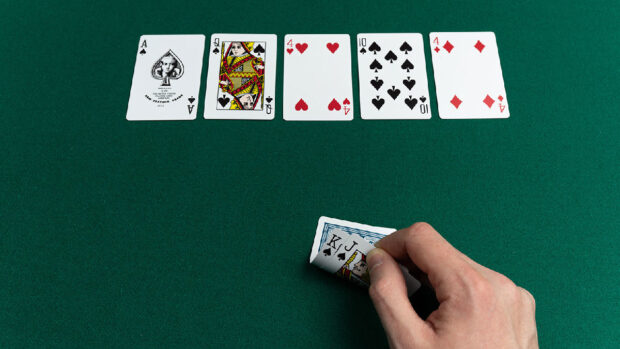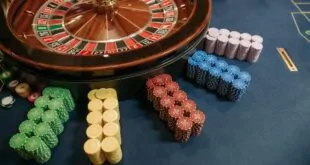Understanding how betting patterns inform hand ranges is pivotal in making informed and strategic decisions at the poker table. Analyzing these patterns allows for a refined interpretation of an opponent’s potential holdings.
This article will explore the specific strategies and mechanisms for narrowing down an opponent’s range based on their betting patterns. It addresses the importance of position, bet sizing, board texture, deviations from standard plays, and player types.
Key Points:
- Betting patterns reveal critical clues about an opponent’s hand range.
- Position affects the strength of hands an opponent bets with.
- Bet sizing often signals hand strength or bluffs.
- Board texture impacts viable hands in an opponent’s range.
- Deviations from standard play expose weaknesses or strategy shifts.
- Opponent types dictate their betting tendencies and predictability.
Position and Betting Patterns
You and your opponent’s position at the table impacts hand reading. Generally, bets from early positions reflect stronger hands due to the necessity of withstanding subsequent betting. In contrast, aggressive betting from late positions can be more deceptive and suggest a wider range of hands. Early position players usually rely on solid hand foundations, whereas late position players may exhibit heightened aggression with a broader hand range.
Consider, for example, a player who consistently raises pre-flop with a narrow set of strong opening hands but opts for a larger continuation bet only when they have hit the flop. This pattern could indicate that whenever their continuation bet size is smaller, it is potentially a bluff or semi-bluff.
Observing betting patterns, such as hesitation before raising or instant checks, can help refine your understanding of an opponent’s strategy. Relating this to broader poker strategies, these observations can be supplemented with an analysis of poker hands in order to better predict the hands in possession and adjust your betting strategies to maximize potential gains and minimize losses.

Importance of Frequency Analysis
Frequency analysis helps identify how often opponents bet or check in specific situations.
- Track continuation bet frequency ─ Note how often an opponent continuation bets, as consistently high frequencies may indicate bluffs.
- Check vs. raise tendencies ─ Observe if opponents check-raise frequently or opt for passive plays. This helps detect when they switch gears.
- Betting on draw-heavy boards ─ If an opponent frequently bets on boards with flush or straight draws, they might be disguising weaker hands.
Analyzing Betting Patterns
Constructing a probable range of their hands is essential when observing an opponent’s betting tendencies. This involves recognizing their opening hand range, their reactions to 3-bets, and how they handle the post-flop game. For example, if an opponent raises pre-flop, you can estimate their hand range depending on their position and bet size. A raise from a late position typically suggests a much broader range than a raise from an early position.
Attention to bet size can reveal an opponent’s hand strength. Some players bet larger to protect strong hands, such as top pairs, sets, or two pairs, while others might make smaller bets with marginal holdings. Consistent behavior in this respect can be exploited. Noting any deviations from these patterns is important in narrowing an opponent’s range.
The texture of the board plays an equally important role. A turn card completing a potential flush or straight greatly affects which hands remain viable in an opponent’s range. Understanding these fluctuations helps isolate the most likely holdings. Observing how an opponent interacts with changes in board conditions further refines one’s strategic responses.
Recognizing patterns in an opponent’s sequential betting actions can offer valuable insights. Observing how an opponent behaves through different betting rounds provides a deeper understanding of their strategy. For example, consider an opponent who raises pre-flop with strong hands yet opts for a larger continuation bet only when hitting the flop. Such patterns suggest smaller continuation bets are likely bluffs or semi-bluffs. Recognizing such patterns allows you to better adjust bets and anticipate your opponent’s strategic maneuvers.

Deviations from Norms and Consistent Patterns
Attention to abnormal betting behavior provides valuable information. An opponent who typically bets robustly but opts to check can signal weakness. Conversely, an opponent is usually passive but displaying aggression could indicate a strong or dramatically improved hand.
Exploiting consistent betting patterns is equally critical. Players whose betting patterns consistently align with certain hand categories are more predictable. For example, an opponent regularly bets with flush draws and then value betting only when hitting offers clues to exploit. Players who avoid raising in multi-person pot situations unless holding an exceptionally strong hand also telegraph their strength when they do raise. This allows for strategic adjustments.
Leveraging Bet Sizing Patterns
Bet sizing patterns offer specific clues:
- Large bets ─ These often indicate protection of strong hands or deliberate overbetting as a bluff.
- Small bets ─ Watch for these on dry boards as they may signal marginal holdings or traps.
- Sudden bet size changes ─ Sudden increases or decreases often suggest an adjustment in strategy or hand strength.
Understanding Opponent Player Types
An accurate understanding of the type of opponent you face aids hand-reading. Tight and passive players are easier to deduce as they bet and raise predominantly with strong hands and rarely bluff unless confident of their hand’s merit. When such players show aggression, it likely indicates a strong holding. Conversely, tight and aggressive players balance aggression with solid hand selection.
In contrast, loose and passive players, sometimes termed by poker enthusiasts as fish, play unpredictably. Their undisciplined play style can be exploited for profit without detailed hand analysis by adopting straightforward approaches focusing on value betting and strategic aggressiveness.

Binary vs. Weighted Ranges
In poker, decision-making often divides into binary or weighted approaches. Binary approaches involve consistent actions with specific hands. In contrast, skilled players adopt weighted ranges wherein decisions account for multiple factors beyond hand strength. Understanding, if opponents adopt binary or weighted ranges, informs accurate hand-reading and strategic planning.
Regular practice incorporating a range of construction tools enhances these skills. Developing proficiency in recognizing how various elements, such as position, opponent tendencies, and potential board interactions, inform betting patterns optimizes hand-reading capability. Keeping diligent notes on regular opponents augments this process. It offers valuable insights into their tendencies and facilitates more precise range estimations.
Effective hand-reading hinges on the systematic analysis of betting patterns, positions’ influences, and players’ tendencies. Poker players can dramatically improve their strategic proficiencies and enhance profitability at the table with consistent practice and leveraging available tools.
 Jewel Beat
Jewel Beat

